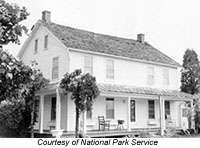|
 The First Lady will travel to Auburn, New York, home to the 30-acre site
where Harriet Tubman (1821-1913) settled with her second husband, Nelson
Davis, and where she established the Home for the Aged in 1903. The Home
for the Aged was designated a National Historic Landmark in 1975. The
site receives approximately 5,000 visitors per year, including annual
pilgrimages from southern African Americans. This year the site will
celebrate the 85th anniversary of her death.
The First Lady will travel to Auburn, New York, home to the 30-acre site
where Harriet Tubman (1821-1913) settled with her second husband, Nelson
Davis, and where she established the Home for the Aged in 1903. The Home
for the Aged was designated a National Historic Landmark in 1975. The
site receives approximately 5,000 visitors per year, including annual
pilgrimages from southern African Americans. This year the site will
celebrate the 85th anniversary of her death.
The site includes:
- The brick house, built circa 1880, where Nelson and Hariett
Tubman Davis lived after their marriage in 1869, and willed to
Tubmans relatives upon her death;
- The Home for the Aged, a wooden building, where Tubman spent the
last few years of her life; restored in 1949 and now a historic
museum open for tours;
- The ruins of the second building of the Home for the Aged,
destroyed by fire in 1949; The Harriet Tubman Memorial Library,
built in 1978, containing historical documents, photos and a
computer lab; and
- The Multipurpose Center, built in 1983 and used for special events.
Historical Significance
Though not directly associated with Tubmans activities with the
Underground Railroad, the brick home of Nelson and Harriet Tubman Davis
and the associated Home for the Aged are two of the very few documented,
tangible links to Harriet Tubman, renowned leader in the Underground
Railroad movement and known as the Moses of her people.
Born into slavery in Dorchester County, Maryland, as one of eleven
children of Harriet Green and Benjamin Ross, Tubman gained her freedom in
1849 when she escaped to Philadelphia. Working as a domestic, she saved
money until she had the resources and contacts to rescue several of her
family members in 1850. This marked the first of 19 trips back into
Maryland where Tubman guided approximately 300 people to freedom, many to
St. Catharine, Ontario, Canada. Tubman rented a room in a St. Catharine
boarding house behind the African Methodist Episcopal Church between 1851
and 1858. At one point, rewards for her capture totaled $40,000. In
1859, Tubman relocated to Auburn, New York and entered into a contract
with William H. Seward to purchase 7 acres. Shortly afterward, Tubman
brought her parents from Canada to settle them on this property.
While living in Auburn, Tubman married Nelson Davis and became very
involved with her church, the Parker Street African Methodist Episcopal
Zion Church, where her husband was an elder. The existing church is
nearly intact from its date of construction in 1892.
Having for years harbored the needy in her home, Tubman purchased the
25-acre parcel adjoining her home at a public auction in 1896. The frame
building on the site became the Home for the Aged. In 1903, Tubman
deeded this 25-acre property to the AME Zion Church. In 1908, the brick
building on this property, lost to fire in 1949 and now just foundational
ruins, was opened as the second building of the Home for the Aged.
Tubman died in Auburn in 1913 at the age of 93. Frederick Douglass once
wrote of Harriet Tubman Davis, Excepting John Brown -of sacred -I know of
no one who has willingly encountered more perils and hardships to serve
our enslaved people than [Harriet Tubman]. She was carried from the
Parker Street AME Zion Church to her gravesite across the street in Fort
Hill Cemetery where she was buried with military rites. The following
year, the City declared a one-day memorial to this courageous champion of
freedom, and unveiled the Harriet Tubman Plaque, which, to this day,
stands at the entrance to the courthouse.
Preservation needs
The overwhelming preservation need at the site is gathering historic
documentation about the site and assessing the historic buildings and
landscape (there was an orchard on the site and it is believed some
gardening and/or farming occurred here too) so that informed decisions
about the preservation, restoration and rehabilitation of the site can
then move forward. To that end, the City of Auburn has obtained a $4,000
from the Preservation League of New York State to hire a contractor to
prepare a National Register nomination for the majority of the site which
is not included in the National Historic Landmark designation. A grant
request has been submitted to the NY State Council of the Arts
Architecture Planning and Design Program for $10,000 to prepare measured
drawings of existing conditions of the Tubman Davis home and the Home for
the Aged. A decision on this grant is pending. State Senator Nozzolio
has proposed $50,000 for the site through the states Community Facilities
Assistance Program (administered through the Empire State Development
Corporation). The Home for the Aged has been owned by the AME Zion
Church for 40 years who rehabilitated in 1949 what had become an
abandoned shell. Currently the Home is in need of structural repair and
some interior renovations to more accurately depict the historic
appearance during Tubmans time.
Harriet Tubmans former residence, built circa 1880, is currently vacant
with the interior mostly demolished. The interior rehabilitation has
been put on hold until investigation of the structure itself can provide
clues as to the original design of the house. The mortar between some of
the bricks on the rear wall is missing, causing water to leak into the
house. The foundation also leaks. The house is in dire need of
restoration and an effort will be made to preserve its historical
significance.
|

